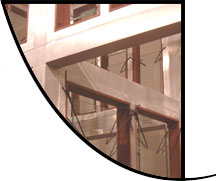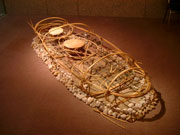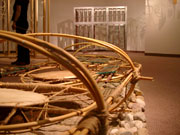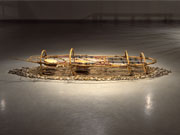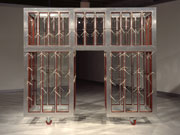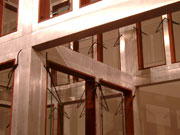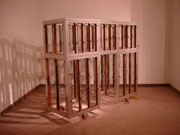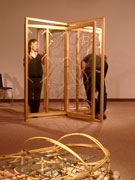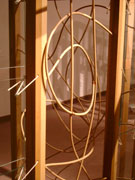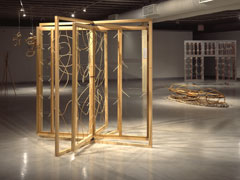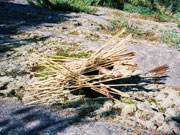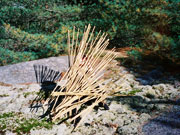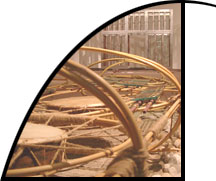 |
| |
| |
Photo by: B. Prophet |
Photo by: B. Prophet |
Photo by: Jaroslaw Rodycz |
| |
THE SONIC HEREAFTER (1997)
is a life sized sarcophagus shaped structure of rattan and purple heart wood which lies on a bed of sand and rocks. The 'head and torso' of the figure within the sarcophagus is fashioned out of two drums woven into the rattan frame. The figure's 'legs and arms' are glass notes which rest on dowels of purple heart wood. The player(s) must kneel or bend over the figure to play the instrument. Bent rattan sticks are used instead of mallets. The Sonic Hereafter blends the earth tones on the head and heart with the ethereal sounds of the limbs. This sculpture premiered at Pekao Gallery , Toronto, November through December 1997. Barry's poems 'The Shaman's Drum' and 'Talisman' appeared on either side of it.
|
| |
| |
Photo by: Jaroslaw Rodycz |
Photo by: B. Prophet |
Photo by: B. Prophet |
| |
| THE TRANSPARENT TONE ARCH (1993)
is made of aluminium box tubing and purple heart wood. One hundred and four micro tonally tuned glass notes are suspended by nylon cord. The lintel arch structure is on wheels so that the sculpture can travel from one performance area to another. The Transparent Tone Arch can also be moved as it is being played creating a uniquely interactive relationship between the music and the performers. The Transparent Tone Arch's dimensions (7.5'h x 6.5'w ) demands that the musicians change levels and
direction as they perform. This sound sculpture was created with the financial support of the Music Office of the Ontario Arts Council. The Transparent Tone Arch was premiered in Basic Elements' production 'Glass Oracles' at the Music Gallery, January 1993. 'Glass Oracles' was produced with creative development funds from the Laidlaw Foundation. Basic Elements was joined by guest artists Barbara Morrison (piano) and David Jaeger (electronics). Mr. Jaeger's participation in the project was made possible through the Ontario Arts Council's Commissioning Program. New works for the Transparent Tone Arch premiered in February 1995 at the Music Gallery in Basic Elements' 'Glass Oracles and Talismans'. This production was taped by CBC Radio's Two New Hours for airing later in the year. The Laidlaw Foundation provided creative development funds for new works created in collaboration with guest artists Barbara Morrison (piano) and Ben Grossman (percussion). |
| |
| |
Photo by: Ben Grossman |
Photo by: B. Prophet |
Photo by: Jaroslaw Rodycz |
| |
|
THE REVOLVING TONE DOOR (1991)
is comprised of poplar framing, 6 mm glass and hand woven rattan grid work. The Revolving Tone Door explores chromatic increments of the A flat major scale and the transparent/reflective interplay of glass and woven rattan. A half inch steel rod connects the exterior support structure and the internal revolving door system. The weight of a mallet striking the glass notes has enough force to initiate the revolving doors. The player must then follow the door as it travels around and around. Revolving Tone Door was premiered at the Art Gallery of Algoma, Sault Ste. Marie, and has since been exhibited at the McMichael Gallery.This project was completed with a materials grant from the OAC's Visual Arts Office. |
| |
|
|
Photo by: B. Prophet |
Photo by: B. Prophet |
Photo by: B. Prophet |
| |
|
THE BAMBOO QUIVER (2002)
A Quiver is a bundle of bamboo or copper rods tied in a row at approximately the centre of the rods which may vary in length from approximately 2 to 8 feet. When laid flat on the ground a quiver resembles a mat stretching from 2 to 30 or more feet, depending on number of rods used. The original Bamboo Quiver, made of forty-three 5ft rods tied with jute cord into a 4ft span, has been featured in dance performances by Janice Pomer with electro-acoustic music performed by composer/performer/sculptor Barry Prophet. This Quiver was first presented in an outdoor performance at The Tree Museum (Gravenhurst) Sept. 2002 with subsequent performances at the Music Gallery (2003), Older & Reckless dance series (Dance Makers Centre for Creativity) and another outdoor performance at Sound Travels (Toronto Islands 2004). When used as a performance sculpture, the Quiver springs into kinetic and sonic action rattling and crashing into shapes metaphoric and abstract. The dancer alternately coaxing the piece into shapes and improvising with the subsequent results. |
| |
Other Sculptures |
| |
|
THE RING CHAMBER (1983)
was created by Barry Prophet and Ian Lazarus in 1983 with support from the Canada Council's Exploration Program. The Ring Chamber is in an hexagonal form, 8'd x 12'w x 8'h. The structure is made out of 2" rectangular aluminium tubing. Wood (paduk) and glass notes are suspended and plate supported. Brass chimes, sand cast gongs and half a dozen cymbals of varying dimension are combined with the wood and glass notes to create a vast array of sonic textures. The Ring Chamber was premiered at Theatre Passe Muraille in 1983 with the personal support of the late Dr. N. Laidlaw. Barry Prophet toured this solo show throughout southern Ontario and to Quebec's Rendez-Vous International Sculpture Symposium in St. Jean - Port Joli in 1984. Projections/Reflections, the Ring Chamber dance show premiered at the Music Gallery in November 1985. That show toured to many of Ontario's art galleries and alternative performance spaces including the Art Gallery of Windsor, Hart House, University of Toronto and Artspace Peterborough. |
| |
THE GLASS BOX (1987)
is a 5' 6" cubic percussion performance sculpture containing fifty two notes of varying dimensions. The glass notes are vertically suspended from the poplar columns and swing gently when they are played. The Glass Box was premiered at the Ontario Science Centre in December 1987 and has since toured most of the province's art galleries and alternative performance spaces (see BASIC ELEMENTS company highlights sheet). The Glass Box was created with the support of the Ontario Arts Council's Music Office and the kind generosity of the late Dr. Nicholas Laidlaw. |
| |
Copyright Janice Pomer & Barry Prophet (c) 2005 |
|

